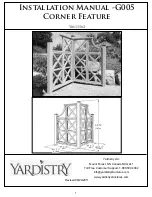
Caution
Be familiar with handling livestock prior to use of this
equipment. Working with livestock carries inherent risk of
injury or death.
Livestock Safety
1
One of the most important issues for consideration when handling
livestock is safety. Although considered domesticated animals, working
with livestock carries with it an inherent risk of danger. It is important to
understand that livestock have both instincts and habits, known as
behavior patterns, that are based on actions that make them the most
comfortable. These instincts and habits allow them to react to changes
in their environment. Many instincts and habits are strong and potentially
dangerous. Using common sense, practicing caution, and understanding
livestock behavior can greatly reduce a handlers risk and enable him or
her to work safely with livestock. This article will detail some important
livestock behaviors as well as cautionary tips to practice when handling
livestock.
Livestock Behaviors
Animals who are used to being around other livestock can become
frightened and agitated when separated, becoming dangerous and
difficult to handle.
The maternal instinct is also very powerful. Many times these
instincts are not evident in an animal’s behavior until shortly after
giving birth. It is important to recognize these behavior patterns and
use appropriate caution.
Another behavior pattern that livestock may exhibit is a territorial
instinct. Feed time is when this instinct is most readily observable.
A valuable behavior is the instinct to follow the leader. Often times,
all that is required is to begin one animal moving and the rest will
follow.
Livestock exhibit the most activity at sunrise and sunset. In
contrast, livestock are the most inactive during night and at midday.
The flight zone is one of the most important principles regarding
livestock behavior and safe handling. It is an animal’s personal
space. Livestock will react in a variety of ways according to a
handlers activities relative to their flight zone. For example,
livestock will face a handler and maintain a safe distance, when the
handler is outside their flight zone. In contrast, livestock will turn
away from a handler who enters their flight zone. Individual animals
will have flight zones of varying size. Working from the edge of the
flight zone will generally keep livestock calm and manageable.
The point of balance is another important behavioral principle to
understand. An animal’s point of balance is located at their
shoulders. An animal will move depending on a handlers position
relative to their point of balance. This principle can be used to
calmly and easily be encourage livestock through crowding pens,
chutes, and squeezes. For example, when a handler stands behind
the animal’s point of balance, the animal will move forward. When
the handler stands in front of an animals point of balance, the
animal will stop or back up. To encourage an animal forward,
simply walk towards the animal, crossing the point of balance, and
it will move forward.
Precautionary Measures
The following are precautionary measures that are recommended to
anyone when working with livestock.
Be alert.
It is impossible to fully know or predict an animals
actions. Always be aware of what is happening around you. This is
particularly important when handling livestock at sunrise and
sunset when livestock are most active.
Keep animals together.
Livestock will be more calm and
cooperative when in groups. When alone, they quickly become
agitated and frightened making them dangerous and difficult to
handle.
Carefully approach animals.
Because of the placement of their
eyes, cattle have approximately a 270 degree range of vision.
Despite their range of vision, cattle have poor depth perception,
and are unable to see behind them. To reduce risk, always
announce yourself when approaching an animal.
Leave yourself an out.
Never enter small enclosed areas with
livestock. If unavoidable, always be sure there is always a fast and
easy method of escape.
Avoid quick movements and loud noises.
Livestock can startle
and frighten easily. Move slowly and deliberately around livestock.
Be careful not to create excess noise.
Be patient.
When working with livestock in a crowding pen, chute,
or squeeze, prodding an animal when it has no place to go is
dangerous. Animals can react quickly and violently.
Respect livestock. Do not fear them.
Underestimating an
animal’s size, strength, and speed can result in serious injury.
Always consider mature males to be dangerous. Be aware of
animals who are sick, injured, or otherwise frightened.
Remember that livestock draw upon past experiences and
treatment when reacting to a situation.
Caution
Train new workers and handlers before allowing them to work
with livestock. The majority of the time, accidents with livestock
are the result of human error rather than an animal problem. A lapse in
judgment, inexperience, or unpreparedness are major causes of
accidents with livestock. Many times, handlers attempt jobs that require
more assistance than is available. Whatever the reason, many accidents
can be avoided if handlers use common sense, follow safety guidelines,
and make every effort to understand livestock behavior.
4
Safety
Summary of Contents for Calf Table
Page 10: ......




























